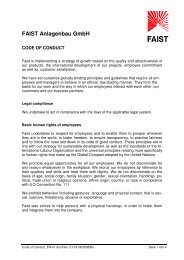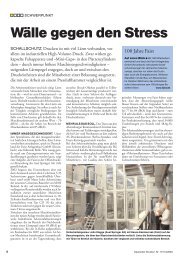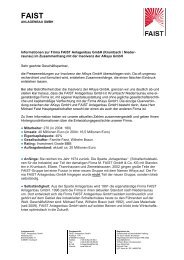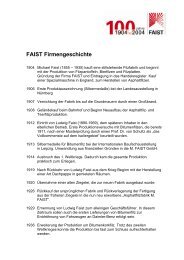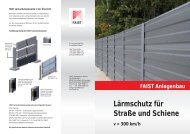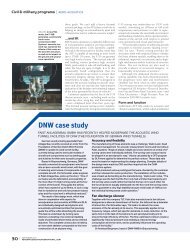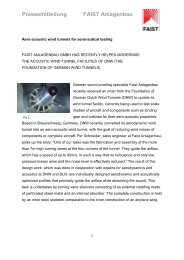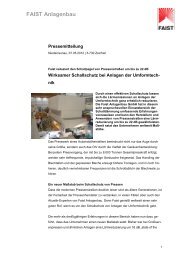Faist - Company History - Faist Anlagenbau
Faist - Company History - Faist Anlagenbau
Faist - Company History - Faist Anlagenbau
You also want an ePaper? Increase the reach of your titles
YUMPU automatically turns print PDFs into web optimized ePapers that Google loves.
FAIST - <strong>Company</strong> <strong>History</strong><br />
1904 Michael <strong>Faist</strong> (1855-1935) acquires an abandoned felt factory and begins<br />
to produce felt slippers, beer coasters and felt mats.<br />
Foundation of FAIST company and incorporation in the trade registry.<br />
Purchase of a machine for producing asphalt felts from England<br />
1906 FAIST products are awarded the silver medal in a national exhibition in<br />
Nuremberg.<br />
1907 The factory is completely destroyed in a fire.<br />
1908 The factory is relocated to its present site (near the station) and<br />
production starts anew with asphalt and bituminous felts.<br />
1912 Ludwig <strong>Faist</strong> (1890-1969) begins working with his father, later to become<br />
the owner. The first experiments with bituminous felt are undertaken,<br />
which had been declared “the best product in the field” in 1911 by<br />
Professor Dr. von Schultz after his careful examination. (Please see<br />
newspaper article)<br />
1913 The company’s bituminous felt is awarded the silver medal in an<br />
international building exhibition in Leipzig. Financial circumstances lead to<br />
the company being converted to M. FAIST GmbH.<br />
1914 World War One breaks out. Production comes to a near standstill.<br />
1919 Ludwig <strong>Faist</strong> returns from the war. He begins production of a type of<br />
roofing felt in a rented location.<br />
1920 An old brick factory is taken over and extended to the new factory.<br />
1926 The original factory near the station is bought back, and production is<br />
moved from the renovated brick factory to the now newly acquired<br />
Asphaltfilzfabrik M. FAIST (asphalt felt factory).<br />
1929 Ludwig <strong>Faist</strong> is appointed sole managing director. Around this time the<br />
first bituminous felt products for noise reduction in vehicles are delivered<br />
to Daimler-Benz.<br />
1936 The manufacturing line is expanded to include bituminous cork felts.<br />
Despite the Second World War, production is kept up almost to the end.
1945 Trustees are charged to rule the company.<br />
1948 Ludwig <strong>Faist</strong> retrieves the company from the trustees and his son, Ludwig<br />
Jr. (1923-1981) joins the firm.<br />
1953 The company is transformed into the M. FAIST KG. With the beginning of<br />
the reconstruction of Germany after the war, FAIST products are high in<br />
demand.<br />
1960 FAIST is the first company to introduce self-sticking insulation material on<br />
the market. Simultaneously, the manufacturing of multi-layered mats for<br />
VW and Daimler-Benz begins.<br />
1968 The production of foam pieces and deep-drawn parts commences, partly<br />
in rented locations due to lack of space.<br />
1969 Ludwig FAIST jr. becomes managing director after his father’s death.<br />
1972 An additional factory is opened in Ellzee for the manufacturing of foam<br />
pieces and deep-drawn parts.<br />
1974 A new product division “FAIST <strong>Anlagenbau</strong>” is developed: soundproofing<br />
cabins for manufacturing plants, whose production is temporarily located<br />
in the Krumbach factory.<br />
1977 FAIST acquires the neighbouring buildings and factories from the<br />
company Neodon.<br />
1979 Michael <strong>Faist</strong>, Ludwig jr.’s son, is introduced into the family business.<br />
1981 Ludwig <strong>Faist</strong> dies unexpectedly and much too soon to be able to hand<br />
over the management to his son. The company is managed internally by<br />
managing directors.<br />
1991 The company Scharenberg from Neuwied is bought out and incorporated<br />
into FAIST <strong>Anlagenbau</strong> branch.<br />
1993 Michael <strong>Faist</strong> takes over the sole responsibility for the company as<br />
managing director and major shareholder.<br />
1996 The plant engineering branch FAIST <strong>Anlagenbau</strong> moves to its own<br />
location in Niederraunau. It’s now leading the world market with its<br />
industrial insulation materials. That same year, the former Nokia factory is<br />
procured in Ziemetshausen in order to expand the production possibilities<br />
for synthetic injection moulding and varnishing.<br />
1999 The automobile branch is consolidated into the FAIST Automotive GmbH<br />
& Co. KG. FAIST acquires the former Vögele factory in Thannhausen and<br />
establishes FAIST Tooling GmbH. This entails moving all the previously<br />
scattered tool manufacturing processes into one location, including stateof-the-art<br />
manufacturing tools.<br />
2000 FAIST takes over a factory in Rudisleben, near Erfurt which has<br />
production plants for fleeces and their various finishes, such as stamping<br />
and pressing. The new company is named FAIST Ecotex GmbH. This
year also witnesses the FAIST Baustoff GmbH being renamed to the emfa<br />
Baustoff GmbH and the move to its new location in Burgau.<br />
2002 FAIST Automotive GmbH & Co fuses with CWW-Gerko Akustik GmbH<br />
and the RKT Kunststoffe GmbH and forms a new corporate group under<br />
the name of AKsys GmbH. The FAIST Group (the major shareholders<br />
being the <strong>Faist</strong> family) retains FAIST <strong>Anlagenbau</strong> (plant engineering) with<br />
its nearly 200 employees and emfa Baustoffe (building materials) with its<br />
8 employees.<br />
2004 The FAIST Group celebrates its 100 th birthday with friends and employees<br />
2007 FAIST <strong>Anlagenbau</strong> GmbH looks back on a brilliant business development.<br />
Within 4 years, the company succeeded in doubling its turnover: in 2004 it was<br />
16.5 million €, then raised up to 30.5 million € in 2007. The goal of realizing a<br />
turnover of 33 million € in financial year 2008 seems to be in easy reach.<br />
Currently, FAIST employs a staff of 235 persons, 28 of them being trainees.<br />
Main business fields are: acoustic measurement rooms, power plants, aeroacoustic<br />
wind tunnels as well as classical soundproofing measures for printing<br />
machines.<br />
2008 The new office building has been completed. FAIST employees move into modern<br />
workplaces in a bright and friendly ambiance.<br />
2009 On 31st March ends the most successful financial year of the whole company<br />
history. FAIST <strong>Anlagenbau</strong> GmbH achieves a record turnover of 40 million Euro.<br />
2010 FAIST opens its new training center FACE and achieves the construction of a new<br />
production hall. Meanwhile, on average 40 young men and women pursue their<br />
training at FAIST.<br />
2011 FAIST <strong>Anlagenbau</strong> puts into operation its new automated sheet metal fabrication<br />
line.<br />
2012 FAIST’s aluminium sound proofing panel gets the authorization of the Deutsche<br />
Bahn AG for its application on high speed railway tracks up to v = 300 km/h.<br />
Social commitment of the company: there are two projects per year apprentices<br />
can voluntarily participate in. In April, our apprentices and active seniors from the<br />
AWO senior home in Krumbach spruce up the home’s garden. In June, some<br />
apprentices participate as volunteers in the health programme of the Special<br />
Olympics in Munich.



